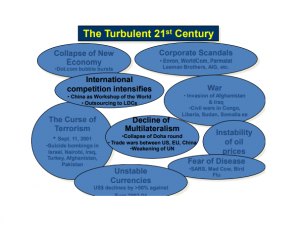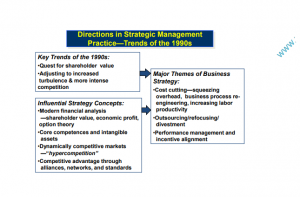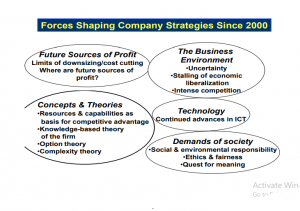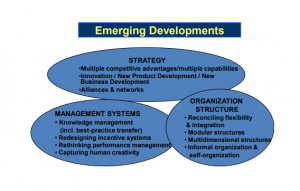External
• PESTEL – Political, Economic, Societal, Technological, Ecological and Legal and regulatory factors
• Competitive environment-Industry Analysis – Porter‘s Model,
• Strategic groups
Internal:
• Organizational Capability analysis- SWOT matrix, Value Chain analysis
• Organization Structure
• Culture (Belief, expectation, Values)
• Resources (Assets, skills, competencies, knowledge)





Implications of the dynamics in external environment
• Speed of environmental changes increasing
• Our organizations are very vulnerable
• Increased foreign competition
• Increased local competition
• Appropriate response to environmental change key for future success
• Anticipate change
Respond on a timely basis
VISION AND MISSION OF THE FIRM
1.Vision and mission provide direction and scope for the firm‘s activities.
2.Vision and mission also provide guidance for the firm‘s strategic objectives and strategies.
Vision:
Vision is usually incorporated in the firm‘s mission document. Vision addresses the question: where do we want to be? This is the first question to be asked in a strategic planning process. Vision refers to what a firm is trying to do or to be i.e. what the firm aspires to be in the future. Vision is the firm‘s ideal future. It is a dream reflecting the best of an organization e.g. the vision of Kenya Airways is to be the “World’s favourite airline‖. A good vision incorporates a level or standard of performance, which level or standard should represent the very best attainable by the organization e.g. ―World‘s favourite‖ for Kenya Airways.
Mission:
While a statement of vision focuses on the future, a mission statement is concerned with the present. Vision refers to what the firm is trying to do, while mission refers to how what the firm is trying to do will be done. For example, what will Kenya Airways have to do in order to be the ―World‘s favourite airline‖? Kenya Airways will have to do the following, among others:
- Provide excellent on-board service.
- Provide excellent inter-connections to any part of the world.
- Provide excellent bookings and reservations.
- Have on-time departures and arrivals.
- Have reasonable fares.
- Provide comfortable flights.
- Provide excellent safety and security.
- Use state-of-the-art aircrafts.
These services would need to be incorporated in Kenya Airways mission statement. What a firm does to realize its vision constitutes the business of the firm i.e. what the firm exists for. A mission statement must be formulated carefully if the vision is to be realized. The following issues or questions, therefore, have to be addressed: What is the firm‘s business? The scope of a firm‘s business may be defined in terms of:
- Products/services
- Markets
- Activities
What are the firm‘s core values? Core values govern how the firm does its business e.g. norms to be observed, and reflect the firm‘s culture and attitude. How will the firm relate to its major stakeholders e.g. customers, employees, government, and the general public? The goodwill of stakeholders is important for a firm in realizing its vision. What corporate policies should the firm adopt? Policies facilitate performance by reducing uncertainty and serving as instruments of empowerment. Everybody in the organization should share and champion the vision and mission of the organization. This requires:
- Incorporating the vision and mission in opening remarks of seminars and workshops.
- Recruiting people with the right aptitude.
- Making vision and mission part of the orientation.
- Recognizing behaviour and performance that gives prominence to the vision and mission.
- Conspicuously displaying the vision and mission within the organization‘s premises.
- Including the vision and mission in the organization‘s pamphlets, bulletins and other publications.